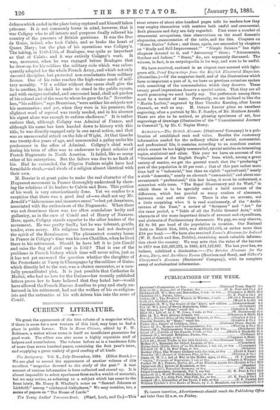CURRENT LITERATURE.
We greet the appearance of the first volume of a magazine which, if there is room for a new venture of this kind, may hope to find a place in public favour. This is Home Chimes, edited by F. W. Robinson, a writer whose name is itself no insufficient guarantee for good work. The editor can also name a highly reputable staff of helpers and contributors. The volume before us is a handsome folio of more than seven hundred pages, containing the first year's issue, and supplying a great variety of good reading of all kinds.
The Antiquary. Vol. X., July-December, 1884. (Elliot Stock.)— We are glad to record the appearance of another volume of this excellent "magazine devoted to the study of the past." A vast amount of curious information is here collected and stored up. It is almost impossible to select specimens from such a wealth of material; but we may notice, as referring to a subject which has come to the front lately, Mr. Henry B. Whalley's notes on "Samuel Johnson at Lichfield," among "celebrated birthplaces." We may mention, too, a series of papers on "The House of Lords."
The Young Ladies' Treasure-Book. (Ward, Lock, and Co.)—This
stout octavo of about nine hundred pages tells its readers how they may employ themselves with matters both useful and ornamental. Both pleasure and duty are dilly regarded. First come a number of ornamental occupations, then observations on the small domestic elegancies, ornamentation of the table, and the like. Chapters on "Home Duties" follow ; and these, again, are succeeded by chapters on "Study and Self-Improvement." "Simple Science" has eight chapters devoted to it, and "Astronomy" three ; "Amusements, Outdoor and Indoor," "Dress," &c., are separately discussed. The volume, in fact, is an encyclopaedia in its way, and sure to be useful.
We have received, enclosed in an elegant case covered with lightgreen Bilk, Proof Engravings from the English Illustrated Magazine. (Macmillan.)—Of the magazine itself, and of the illustrations which form so important a part of it, we have on previous occasions spoken with something of the commendation which they deserve. These twenty proof-impressions deserve a special notice. That they are all worth possessing we need hardly say. The preference among them must be a matter of taste. Personally, we are inclined to like the "Martin Luther," engraved by Herr Theodor Enesing, after Lucas Cranach, as well as any. M. Octave Lamar gives an excellent engraving, after a portrait by Mr. F. Sandys, of Mr. Matthew Arnold. There are also to be noticed, as pleasing specimens of art, four engravings of drawings (illustrative of the "Unsentimental Journey in Cornwall"), by Mr. C. Napier Hemy.
ALMANACS.—The British Almanac (Stationers' Company) is a publication of established rank and value. Besides the customary information needed for the ordinary affairs of social, commercial, and professional life, it contains, according to an excellent custom which cannot be too highly commended, special articles on interesting topics, statistical and other. This year we have an account of the "Occupations of the English People," from which, among a great variety of matter, we get the general result that the "producing" part of the population is 43 per cent. ; that of this part rather more than half is "industrial," less than an eighth "agricultural," nearly a sixth "domestic," nearly an eleventh "commercial," and about oneseventeenth "professional," this last being, it must be understood, a somewhat wide term. "The Royal Observatory and its Work," in which there is to be specially noted a lucid account of the difference, which has puzzled so many readers of almanacs, between real and solar time. There is also an account, not a little surprising when it is read continuously, of the "Architecture of the Year," a review of "Sciences" and "Art" for the same period, a "Table of all the Public General Acts," with abstracts of the more important details of revenue and expenditure, and abstracts of Parliamentary documents. We pay, we may observe, £2 8s. 9d. per head of the population in taxation. Oar National Debt on March 31st, 1884, was £640,631,095, or rather more than £18 per head.—We have also received Eason's Almanac for Ireland (W. H. Smith and Son, Dublin), containing much valuable information about the country. We may note that the value of the harvest in 1879 was £21,397,275, in 1883, £31,127,837. The last year has, we believe, exhibited a diminution.--The Service Almanac for the Army, Navy, and Auxiliary Forces (Harrison and Sons), and Gilbert's Clergyman's Almanac (Stationers' Company), with its complete array of ecclesiastical information.






































 Previous page
Previous page